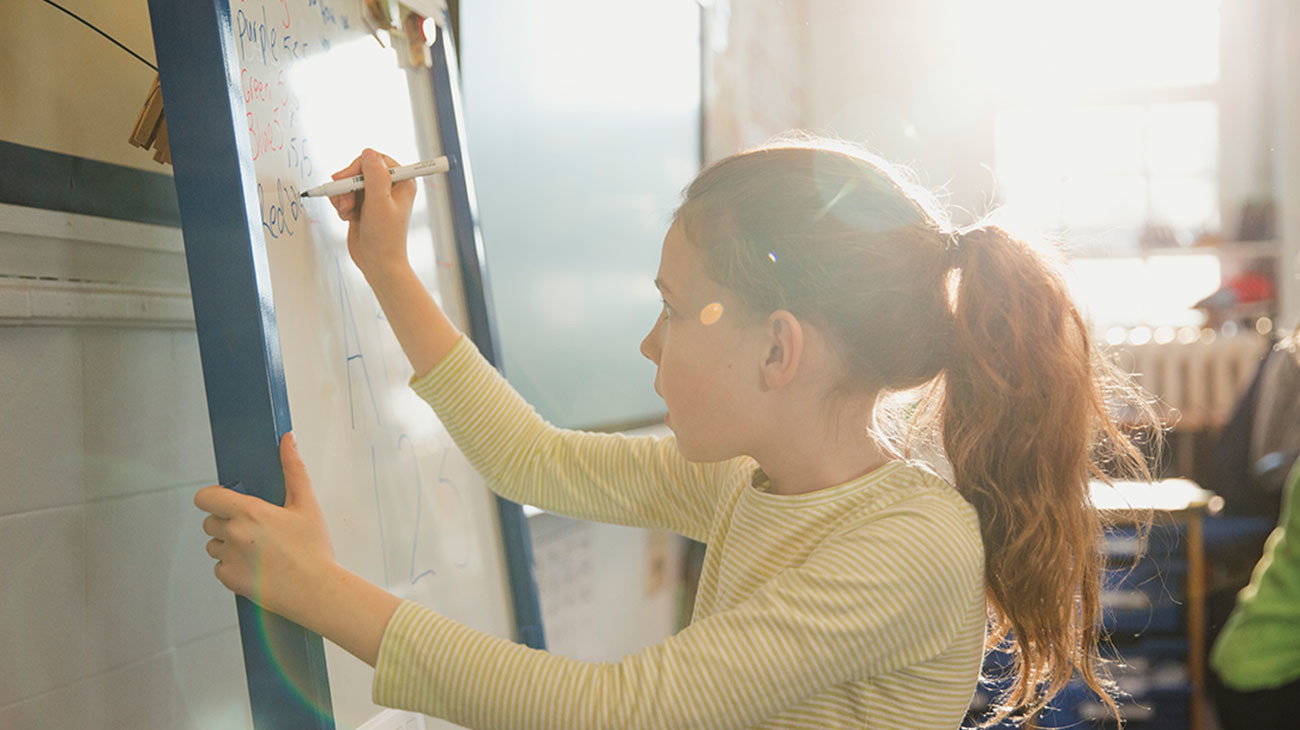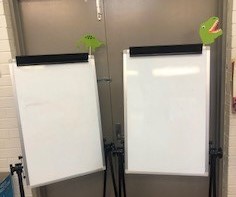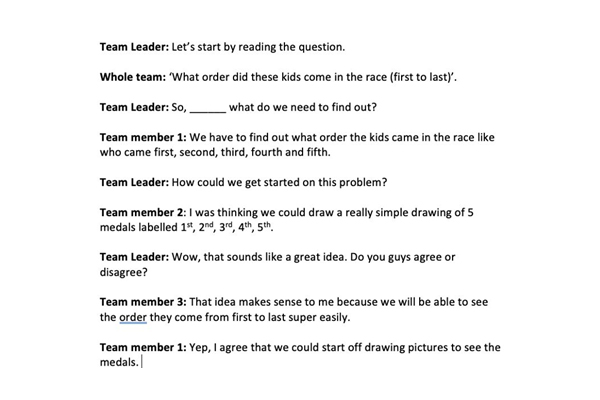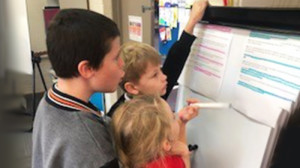Posted Tuesday, 20 May 2025
Scitech to spark science curiosity across the Kimberley
Scitech is embarking on an epic tour across the Kimberley, visiting 26 remote community schools.
Emily Jansen uses the basics of problem solving to steer her challenging students on a course for success.

Hello everyone! I’m Emily Jansen, a year 3 teacher at Bungaree Primary School in Rockingham.
When I started the Alcoa Champions of Maths program, there was one instruction that stood out to me: “Make your groups random.”
Although I was skeptical, I was prepared to give it a shot. Well. Did Shyam and I both learn a valuable lesson the first time I delivered a problem-solving lesson in the format launch, explore, discuss! Fighting, yelling, walking away from their group, scribbling, markers thrown, people erasing others’ work etc. Afterwards, I was traumatised. BUT prepared to make a lot of changes so my students could be successful. 🙂
My class poses some significant behavioural challenges and up until this point, had only engaged in Explicit Direct Instruction mathematics lessons. So, it was probably not that unexpected that my students would respond so poorly when they were required to learn in a more unstructured way (with the added challenge of working in groups).
In our post-coaching session, Shyam and Tim encouraged me to start out small and change my learning goals to something simple and unrelated to maths. For example, taking turns to write a silly sentence, taking turns to draw a picture of the ocean etc. I was able to take this feedback and create a sequence of lessons that would teach my students how to use the whiteboards and work in groups. It made sense that I would teach these expected behaviours in an explicit way. It went like this:
Lesson 1
We are learning expected behaviours when working with whiteboards.
Students brainstormed Expected Behaviours and Unexpected Behaviours when we are working with the whiteboards
We are learning to move into random groups with no put-downs.
Lesson 2
I defined put-downs as criticising yourself or others and being mean to others verbally or non-verbally. As examples, I wrote on individual cards put-downs I had heard my students use (rolling their eyes, saying ‘ugh’, saying ‘I hate Bob’, laughing when another person speaks). In a circle, students shared a time they had been put down and how it felt. ‘A time I have been put-down was when__________. This made me feel _________’.
Once we had established what a put-down was and how it made people feel, we completed a ‘Looks Like’ ‘Sounds Like’ ‘Feels Like’ chart. For two weeks, we made it our mission to stop put-downs. Students were rewarded with popcorn and a TV show when we achieved this goal.
Lesson 3
We are learning to take turns.
Drawing on our previous knowledge of moving to a group with no put-downs, I invited four students to demonstrate and gave them lots of positive praise about moving to a whiteboard with no put-downs, but a smile.
I gave them a theme, for example, the ultimate bathtub. As my group was demonstrating and drawing their bathtubs, I was giving feedback on how as soon as someone finished their drawing, they stood aside and let the next person in. I gave feedback on how quietly they were waiting for their turn. I gave feedback on how they were holding their whiteboard markers tightly while waiting. After 2 minutes, I change the theme. Some possible themes include ocean, zoo, school, dream bedroom, sports etc.
Lesson 4
We are learning to draw simple pictures.
For this lesson, I gave students common objects that might appear in maths questions and asked students to draw them simply and quickly. For example: cars, cats, dogs, people, guinea pigs, chairs, tables, shapes, etc. Using a similar format to last time, I invited a group up to demonstrate drawing simple pictures, taking turns and giving no put-downs simultaneously.
Lesson 5
We are learning about the functions of the whiteboard.
This lesson was aimed at teaching students about the marker holder at the top and the clip function. Again, using a process of ‘I Do, We Do, You Do’, we practised ‘parking our whiteboard markers’ in the specified location and clamping small pieces of paper.
Lesson 6
We are learning how to work in groups.
OKAY… so by this point students were pretty familiar with the whiteboards and understood the norms. It was time to teach them a little bit about how they could work in a team and approach maths questions. Back in the beginning, the problems arose at the explore phase. So, I scripted an exemplar. Luckily, my students LOVE drama, so they really embraced the script. (It was quite enticing for them as well because I said they might get to appear on the Scitech website!)
Part #1: I displayed my ‘random’ groups which had a pre-determined team leader. I filmed different groups moving to their whiteboards with no put downs.
Valuable hint*** In my class, not only did I have to separate students within groups but had to make sure that certain groups were on opposite sides of the room. To achieve this, I stuck a puppet to the top of each whiteboard and placed a picture of the matching puppet to the top of my groups, so students knew exactly where to go and didn’t choose their own whiteboard.
 |
Puppets help students identify their whiteboards. |
Part #2: I gave the team leader two lines. The first line was ‘So team, what is the problem we have to solve?’ Each person in the group then had to say, ‘We have to find out______’.
The team leader asked the second question. ‘How should we start to solve this problem?’ One person responded by saying ‘I think we could start by drawing pictures of students with their medal.’ Another team member had to say, ‘I agree that we should start like this because _____.’
Part #3: Students started taking turns and drawing pictures. The team leader had to give feedback on what they were doing well. ‘Wow guys you are taking turns so nicely.’
Example of a problem solving script:
 |
I made a movie of students and replayed this back to them, so they have an idea of What a Good One Looks Like (WAGOLL)!
Lesson 7
We are learning to solve a maths problem and work in groups.
This was the moment I was building up to! I selected a simple Year 1 problem for my Year 2/3 class because the focus was still on working as a group rather than the maths. The question looked like this
There were 10 guinea pigs in 2 cages. How many guinea pigs were in each cage?
I had explicit success criteria in my Launch and had groups demonstrate this success criteria before working in groups.
We are learning to work in groups for maths.
My students worked absolutely beautifully, and you wouldn’t have believed they were the same kids from the first video! I felt so proud. I’m going to continue to facilitate easy mathematics problems until the group norms become automatic.
As the program goes on, I hope to gradually withdraw this high level of explicitly teaching behaviour.
 |
Students problem solving together. |
Would you like to continue a discussion on this topic with other educators? Join our Facebook group!
If you are interested in joining the Alcoa Maths Enrichment Program please fill out the enquiry form below and a Scitech representative will be in touch with you.
Upon clicking the "Book Now" or "Buy Gift Card" buttons a new window will open prompting contact information and payment details.